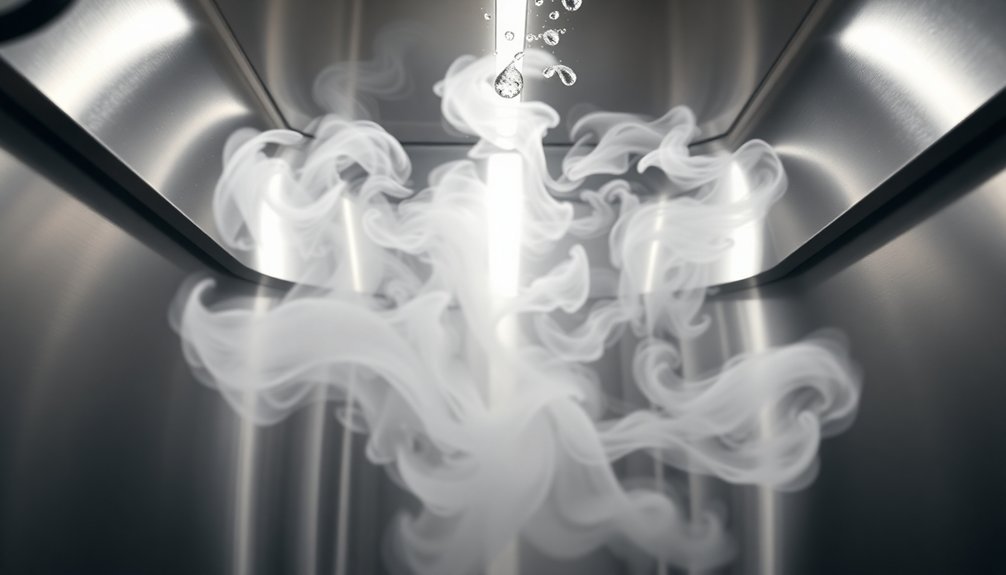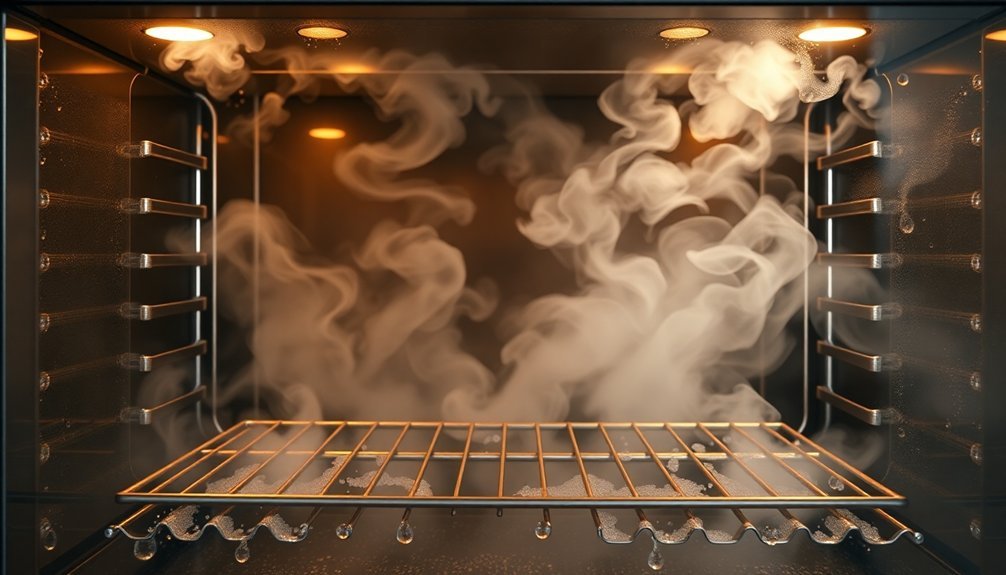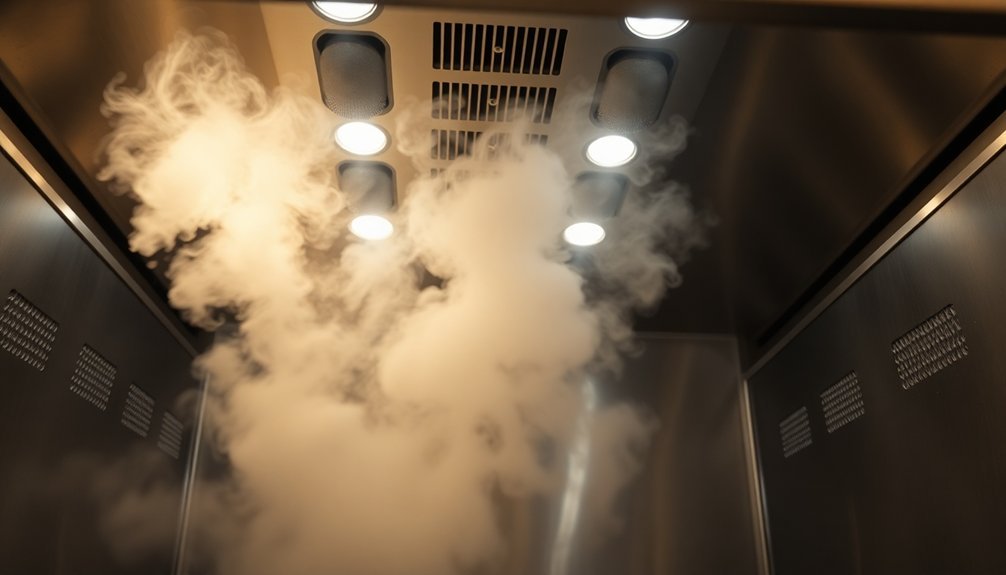Your oven's steam flow performs best when you've optimized several key elements working together. You'll need proper chamber insulation, strategically placed steam injection nozzles, and well-maintained ventilation systems. Control your steam pressure through bronze or gunmetal valves, while using adjustable dampers to manage airflow patterns. Position your loads with enough spacing to allow steam circulation, and adjust fan speeds based on your batch size. Temperature consistency matters too – aim for 190-212°F (88-100°C) depending on your products. By mastering these core components, you'll reveal even more ways to perfect your steam-based baking process.
Chamber Design and Heat Distribution

While effective steam flow depends on many factors in an oven chamber, proper design and insulation form the foundation for ideal heat distribution.
You'll find that thick insulation and high thermal mass materials like stainless steel are vital for maintaining consistent temperatures and preventing heat loss. Incorporating thermal mass elements helps generate robust steam production when water is added.
Your chamber's air circulation system plays a significant role through specialized ducting and adjustable fans that guarantee uniform heat distribution.
You'll want 100% return air surface contact to maximize heat exchange efficiency.
The heating elements work alongside sophisticated PID controllers to keep temperatures within a precise range, typically within 5°C of your target.
To manage humidity effectively, you can use purge systems and variable-speed extraction fans.
These components let you control steam saturation and pressure while allowing for necessary air refreshments to maintain product quality.
Steam Injection System Configuration
Because efficient steam distribution is essential for ideal baking results, your injection system's configuration requires careful consideration of multiple components.
You'll need a bronze or gunmetal control valve to regulate steam flow, a brass controller with sensors for monitoring, and a stainless steel injector nozzle for peak mixing. The steam reaches velocities of 1000m/s through the injection system.
The system works by injecting steam through an annular nozzle, creating small droplets for efficient heat transfer while maintaining controlled pressure.
- Watch in amazement as your system heats 1,000kg from 15°C to 90°C in under 10 minutes
- Feel confident knowing your stainless steel components will stand the test of time
- Rest easy with precise temperature control at your fingertips
- Experience the satisfaction of perfectly distributed steam throughout your chamber
Install your injectors horizontally for the best mixing and circulation, and you'll achieve consistent, professional results every time.
Humidity Control Mechanisms

Since maintaining precise humidity levels directly affects baking quality, your oven's control mechanisms must work in harmony to regulate moisture content effectively.
You'll need to monitor several key components to achieve ideal control. Your purge systems, whether using fixed-speed or variable-speed extraction fans, work alongside adjustable dampers to remove excess moisture.
When you open or close these dampers, you'll notice immediate changes in humidity levels. Modern ovens let you replace moist hot air with fresh air during baking cycles through air refreshment systems.
You can fine-tune steam injection by adjusting the saturation level to maintain perfect humidity. This precision control helps enhance your product's crust development while ensuring efficient heat transfer. The increased oven load from multiple items being baked simultaneously will naturally raise humidity levels within the chamber.
Air Flow Management
You'll notice that precise velocity control systems are essential for managing steam distribution throughout your oven chamber.
Your fan placement strategy must account for both vertical and horizontal airflow patterns to achieve ideal temperature uniformity and prevent hot spots.
The strategic positioning of fans, combined with adjustable dampers and variable speed controls, lets you fine-tune air movement based on your specific baking needs.
Velocity Control Systems
While maintaining proper baking conditions requires multiple variables, air velocity control stands as a cornerstone of modern oven chamber management.
You'll find that precise control systems use sensor arrays to monitor airflow patterns throughout the chamber, enabling you to adjust velocities by zone or quadrant.
When you're managing these systems effectively, you'll achieve consistent heat transfer, ideal moisture removal, and uniform crust formation across your products.
- Picture your products achieving perfect golden-brown crusts every single time
- Feel confident knowing you've eliminated those frustrating hot and cold spots
- Experience the satisfaction of seeing uniform results across every batch
- Trust in your automated system to alert you before quality issues arise
Advanced monitoring systems compile real-time data, allowing you to fine-tune operations and maintain strict quality standards through automated adjustments and alerts.
Fan Placement Strategy
Strategic fan placement serves as the foundation for effective airflow management in oven chambers.
You'll want to position your fans based on your oven's design – above the chamber for top-down vertical airflow or along the sides for horizontal circulation. By mounting fans outside the chamber with shafts extending inward, you'll maintain better temperature control.
For conveyor ovens or hung components, vertical airflow works best, while horizontal patterns suit batch ovens with flat-laid items. You can combine both approaches for complex setups.
When selecting fans, opt for larger units with higher CFM ratings – they'll boost circulation by 15% to 50%. This increased capacity helps eliminate hot and cold spots, ensuring even heat distribution throughout your chamber and achieving temperature uniformity as precise as +/-1°C.
Temperature Zone Optimization

To achieve ideal steam flow in oven chambers, proper temperature zone optimization requires careful control of multiple variables.
You'll need to monitor temperatures up to 212°F (100°C) for general steaming, while adjusting to lower temperatures around 190°F (88°C) for delicate items.
Modern ovens use automated systems that maintain precise humidity levels by activating the boiler only when needed, ensuring consistent results throughout the cooking process.
- Your perfectly steamed fish will melt in your mouth when you master temperature control
- You'll never serve dried-out chicken again with proper humidity settings
- Your family will marvel at restaurant-quality results from your steam oven
- You'll feel like a professional chef as you confidently control multiple cooking zones
The oven's design, heating elements, and sealed cavity work together to maintain ideal steam distribution and temperature uniformity across all zones.
Load Capacity Planning
When you're planning steam-based oven loads, you'll need to establish maximum distribution patterns that account for both horizontal and vertical spacing of products while maintaining proper steam flow.
You must adjust steam flow rates based on the chamber's occupied volume, ensuring uniform heat distribution whether the chamber is partially or fully loaded.
Your load's total weight directly impacts steam performance, so you'll want to carefully balance the mass of products against the oven's steam generation capacity to maintain ideal processing conditions.
Maximum Load Distribution Patterns
Determining maximum load distribution patterns requires careful analysis of both the oven's physical capabilities and the product's heating requirements.
You'll need to calculate the specific heat requirements for your product mass while ensuring uniform temperature distribution through strategic air circulation. Using multiple recirculation fans and well-designed supply plenums creates the essential cross-flow patterns that maintain consistent heating throughout the chamber.
- Feel confident knowing your product receives uniform heat exposure with proper load spacing
- Rest assured that your temperature control system maintains precise tolerances
- Trust in the enhanced airflow patterns that protect your valuable products
- Experience peace of mind with reliable batch-to-batch consistency
Position your loads to maximize the effectiveness of vacuum ports and fan configurations, always keeping within the calculated BTU/hr capacity limits for peak steam flow and temperature uniformity.
Steam Adjustments Per Volume
Three critical variables shape effective steam adjustments in load capacity planning: chamber volume, product density, and moisture content. You'll need to adjust your steam injection rates based on how much space your products occupy in the chamber and their moisture requirements.
| Volume Factor | Steam Requirement | Control Method |
|---|---|---|
| Small Load | Low Pressure | Damper @ 25% |
| Medium Load | Medium Pressure | Damper @ 50% |
| Full Load | High Pressure | Damper @ 75% |
To optimize steam flow, you'll want to monitor your extraction fan speeds and adjust them according to your load size. For smaller loads, reduce steam pressure and fan speed to prevent excess moisture loss. As your load increases, you'll need to boost both steam injection and air circulation to maintain consistent humidity levels throughout the chamber.
Weight Impact on Performance
Successful load capacity planning depends heavily on understanding how product weight influences overall oven performance.
Your product's mass and thermal properties directly impact the heat energy required to achieve target temperatures. When you're calculating steam requirements, you'll need to account for both the product's specific heat and the anticipated heat losses through oven walls and exhaust.
- Feel confident knowing your oven's capacity matches your production needs – no more worrying about underperforming equipment
- Trust in precision-engineered solutions that enhance steam flow for your specific product weight
- Experience peace of mind with properly sized steam generators that maintain ideal saturation levels
- Save energy and reduce costs by implementing exactly the right amount of steam flow for your load
Remember to factor in wall losses, exhaust rates, and steam generation capacity when determining the best settings for your product weight.
Ventilation System Maintenance

Effective ventilation system maintenance plays an essential role in controlling steam flow within oven chambers. You'll need to understand how air moves through your oven, from the bottom door openings to the top vents, to maintain ideal steam levels. While modern ovens are designed to leak for proper airflow, you can control steam retention by sealing gaps around injection points.
| Component | Function | Maintenance Need |
|---|---|---|
| Extraction Fans | Control humidity distribution | Regular speed checks |
| Dampers | Regulate moisture levels | Adjustment calibration |
| Steam Injectors | Maintain saturation | Pressure monitoring |
| Condensate Chamber | Measure steam flow | Level inspection |
Your oven's purge system helps remove excess moisture through variable-speed fans and dampers. You can adjust these manually or through PLC-controlled motorized valves to achieve the perfect balance of humidity and heat for your baking needs.
Frequently Asked Questions
How Does Altitude Affect Steam Flow Patterns in Commercial Ovens?
You'll notice that at higher altitudes, your oven's steam flows less predictably due to lower air pressure. The reduced boiling point affects steam temperature and circulation, making it harder to maintain consistent cooking conditions.
Can Magnetic Fields Influence Steam Distribution Within Oven Chambers?
No, magnetic fields won't affect steam distribution in your oven chambers. Steam's movement depends entirely on temperature, pressure, and airflow patterns. You'll only need to focus on these thermal and mechanical factors.
Do Different Metal Finishes Impact Steam Adherence to Oven Surfaces?
Yes, metal finishes markedly affect steam adherence. You'll find rougher surfaces like #1000 grit enhance steam condensation, while smoother finishes reduce adherence. The oxide layers that form also influence how steam interacts with surfaces.
What Role Does Ambient Room Temperature Play in Steam Flow?
Your room's temperature directly impacts steam flow – higher temps reduce condensation and maintain better flow, while lower temps increase condensation and slow steam movement. You'll need proper insulation to minimize these effects.
How Does Electromagnetic Interference Affect Automated Steam Injection Systems?
EMI will disrupt your automated steam system's control signals, causing inaccurate readings and unstable operation. You'll notice interference with sensors, faulty commands, and reduced efficiency in your steam injection process.
In Summary
You'll achieve ideal steam flow in your oven chamber by focusing on balanced airflow patterns, proper ventilation design, and strategic steam injection points. Your maintenance of clean vents, correctly positioned baffles, and calibrated humidity controls makes a significant difference. Remember to take into account your chamber's load capacity and temperature zones, as these directly impact how effectively steam circulates throughout your baking environment.





Leave a Reply